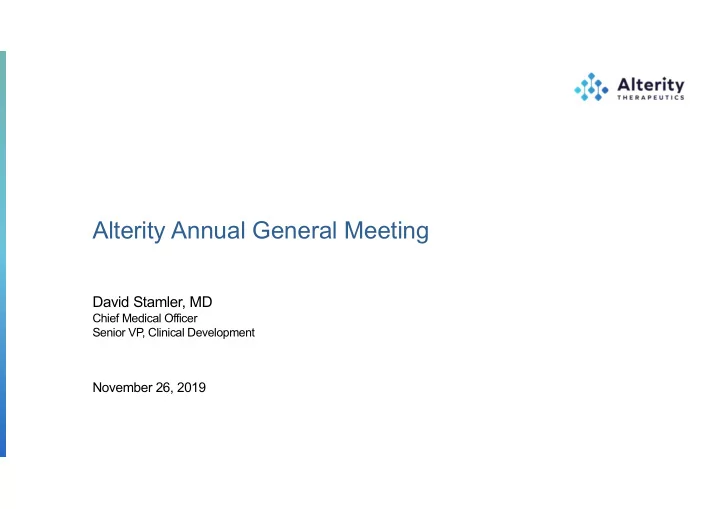

Alterity Annual General Meeting David Stamler, MD Chief Medical Officer Senior VP , Clinical Development November 26, 2019
Clinical Target – Parkinsonian Disorders Significant unmet medical need Parkinsonian disorders include Parkinson disease and atypical forms such as Multiple system atrophy (MSA) and Dementia with Lewy Bodies Atypical forms have ancillary symptoms and a limited response to available treatments Parkinsonism is a syndrome of motor symptoms that include slowness of movement, stiffness and tremor First therapeutic target for PBT434 – Multiple System Atrophy (MSA), a devastating and rapidly progressive neurological disease with no approved treatments Alterity is targeting these neurodegenerative diseases which share a unifying feature – α -synuclein aggregation and increased iron in areas of pathology 2
Orphan Designation PBT434 for the treatment of MSA In January 2019, US Food and Drug Administration (FDA) granted Orphan Drug Designation for PBT434 7 years of market exclusivity for use of PBT434 in the treatment of MSA Development incentives of the Orphan Drug Act 1983, including tax credits for qualified clinical testing • In November 2019, we received positive opinion from the Committee for Orphan Medicinal Products of the European Medicines Agency (EMA) for PBT434 • Anticipate a decision on Orphan Designation from the European Commission in the near term 3
Multiple System Atrophy A form of atypical parkinsonism • Orphan disease Map of brain of • No drug approved for treatment of MSA MSA Patient • Characterized by Parkinsonism (motor symptoms), difficulty maintaining blood pressure and/or problems with gait, balance and coordinating movements • Hallmark of MSA: accumulation of α -synuclein and neuron loss in multiple brain regions Halliday 2015, based on Brain 2015: 138; 2293–2309 4
PBT434 Targets Alpha-Synuclein DOI:10.4236/health.2012.431175 • α -synuclein is an established disease target • Abundant protein in the brain • Critical for normal function of neurons • Key protein involved in neurotransmission • Enables neurotransmitter release through synaptic vesicle fusion to nerve terminal 5
Brain Iron Increased in Areas of Pathology Parkinson’s disease Multiple System Atrophy Patients n = 7 * Substantia nigra (T) n = 9 Healthy n = 8 Cerebral cortex n = 8 * Substantia nigra (pc) n = 11 n = 3 n = 13 n = 8 * Caudate nucleus Cerebellum n = 24 n = 10 0 10000 20000 30000 n = 8 * Putamen (M) n = 10 nmol iron/g of human brain n = 8 Putamen (L) n = 8 Specialized MRI to Measure Brain Iron n = 8 Globus pallidus (M) MSA Healthy n = 9 n = 8 * Globus pallidus (L) n = 11 n = 6 * Substantia nigra (T) n = 9 n = 8 Cerebellum n = 12 0 10000 20000 30000 nmol iron/g of human brain 6 Dexter et al . Brain.1991;114 Courtesy of P. Trujillo, D. Claassen
PBT434 is Efficacious in Parkinsonian Disease Animal Models ↓ α‐ Synuclein aggregation Preserves nigral neurons Improves motor function ** 6 100 ** Parkinson’s 4 disease Model 50 2 0 0 Vehicle PBT434 Vehicle PBT434 Aggregated ** Total N SNpc neurons Atypical Parkinson’s Model Finkelstein et al. Acta Neuropath Comm (2017) 5:53 7 Finkelstein et al. Movement Disorders (2018) Vol. 33, Suppl. 2
Phase 1 Design • Population: Healthy adult and older adult ( ≥ 65 yo) volunteers 600 mg 250 mg bid ≥ 65 years 300 mg 200 mg bid 100 mg 100 mg bid 50 mg Single Ascending Doses Multiple Ascending Doses (6A:2P/cohort) (8A:2P/cohort) 8
Plasma and Spinal Fluid Concentrations of PBT434 Plasma after Single Doses Spinal Fluid at Steady-State 250 Plasma (unbound, ng/mL) 200 150 100 r 2 =0.72 50 0 0 50 100 150 200 250 CSF (ng/mL) CSF concentrations at efficacious doses in mouse Plasma and CSF 11 hours post dose, 200 mg BID Plasma and CSF 1.5 hours post dose, 200 and 250 mg BID Takeaways • PBT434 demonstrated dose dependent pharmacokinetics with a mean elimination half ‐ life up to 9.3 hrs • CSF concentrations of PBT434 at doses ≥ 200 mg BID were greater than those associated with robust efficacy in animal models of PD and MSA 9
Safety of PBT434 • All adverse events (AEs) were mild to moderate in severity • No serious AEs or AEs leading to discontinuation in any subject • Headache was the most common AE in subjects receiving 8 days PBT434 • The AE profile was similar for adult and ≥ 65 year-old volunteers • No clinically significant findings were observed in vital signs, clinical laboratory parameters or 12-lead ECGs 10
Summary Targeting Orphan disease with no approved treatments • Potential peak sales of US$750 million (U.S. only) Development team with proven track record at FDA Lead drug candidate passed Phase 1 • PBT434 was well tolerated with an AE profile comparable to placebo • PBT434 achieved CSF concentrations exceeding those associated with robust efficacy in MSA animal model of MSA Phase 2 planning ongoing • Preparing for FDA interaction • Phase 2 optimization study to start in near term Strong pipeline potential 11
12
Recommend
More recommend